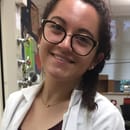During my senior year of high school, a Modern Love column went viral on Facebook: it was titled, “To Fall in Love With Anyone, Do This,” and I was instantly intrigued. The writer in me marveled at the possibilities, and the senior-who-still-hadn’t-had-her-first-kiss was curious about the potential. Could it really be that easy?
Here’s the quick and dirty summary: writer Mandy Len Catron took the principles of psychologist Arthur Aron’s study on interpersonal connections and applied them to a first date. The basic premise of the study? Have two relative strangers sit alone in a room; ask one another 36 questions that get progressively more personal; and then stare into each other’s eyes for four minutes. One of the cross-sex couples fell in love and got married after this experience.
So Catron tried it. And it worked.
In the two and a half years since, the article has stuck with me. There was just something so enticing about the premise. I had purposefully avoided reading the questions—if I did try it, I didn’t want to plan my answers beforehand—so the curiosity about these all-powerful prompts kept me fascinated.
Additionally, there was an element of risk. For the past few years, I have considered trying the experiment with someone, but there was this sort of unconscious pressure to pick “the right guy.” If it was going to work, I wanted it to work with the right one. But how on earth would I ever know if he was right if I didn’t get to know him? The circular logic (or lack thereof) is infinite.
So the article just floated in the back of my mind, resurfacing occasionally when I felt a spark with someone. But I never acted on it, until about two weeks ago.
The experiment came up in conversation one night, and a friend of mine asked me if I was interested in trying it. In the moment, I said yes, and then I started doubting myself. A week passed, and I avoided bringing it up.
Did I want to try my experiment with this guy? Was I picking “the wrong one?” The Right One? Was I putting too much pressure on an experiment that was older than I was (it came out in early 1996)? After a few more days of thinking about it, I finally decided to follow up and ask my friend if he was still interested. He was.
So we did it. We asked each other those 36 questions while sitting out at the tables behind the dining hall. It was one of the last warm nights of the year, and the stars were out. It was also the most unique two hours of my life.
We entered a space of vulnerability and intimacy that felt equal parts squirm-inducing and incredibly cathartic. There was stunned silence and awkward laughter, but there was also a comfortable, contemplative silence and genuine laughter. I cried at one point, and he took my hand for a moment. The four minutes of eye contact were less intense than I thought, though the minutes did stretch out for centuries. We hugged at the end.
Since that night, our schedules have been so busy that we have only had a few conversations in the last few weeks. When we reflected on that late-night conversation under the stars, we both came to the conclusion that those questions hadn’t sparked any kind of love or romantic attraction.
So, did I fall in love with him?
Short answer: No.
Long answer: The conversation was infinitely more valuable than my initial expectations. One of the questions in the experiment has to do with your opinions about love and affection, and my answer really transformed the way I perceived this entire experience.
Ever since I was little, I’ve shied away from physical affection, and, to some extent, sharing emotional affections. I’m not overly touchy-feely, and though I’ve improved on the how-to-hug-like-a-normal-person front, I’ve only said “I love you” a handful of times to people I’m not related to. While I believe myself to be empathetic, encouraging, and honest with my friends, I don’t know if anyone would call me affectionate.
Until recently, the idea of love always had a capital L in my mind. Perhaps my voracious reading habits instilled a kind of magnitude in the concept from a young age, and while I have always dreamed of feeling that capital-L Love, it also terrifies me.
But these past few years have begun to teach me that Love and love are different things. It isn’t always as big as the books, movies, poems, television shows, and advertisements portray it to be. And the alternative to romantic Love isn’t just familial, either.
This experience solidified that for me. My friend and I didn’t fall in love with each other, but we shared vulnerable parts of ourselves in a way that we never have before—and may not ever do again. I don’t Love him because of those questions, but I feel connected to him in a really unique way. The experience has brought us closer together.
Perhaps lowercase-l love settles within the memories of those experiences. I don’t Love the people that I met at the Kenyon Review Young Writers Workshop in the summer of 2014, but I think I’m coming to realize that I love them. The same goes with the Hazantourage, the group of neighborhood friends that have become pseudo-cousins over the years. My cross country and track teams in high school and college. My fourth- and fifth-grade teacher. The families I grew up with in my old neighborhood in Suwanee, Georgia. Perhaps even my close family falls under the lowercase-l love.
And I’m starting to realize that while there’s (sometimes) a bit less drama in love than Love, the experiences that have made my life what it is today have been all the more special because of the love that I found in the people I shared them with.
Because there are different kinds of love. Different species of butterflies that flutter in my stomach—or perhaps love is a moth, because it’s smaller, softer, not always as beautiful and dramatic, but quietly unique. Because moths, at first glance, are not as generically beautiful. Because it takes a little extra work to appreciate the beauty of a moth. Because once you find the value in them, the more you start to love them, too.
Image Credits: Taylor Hazan, 1, 2, 3


